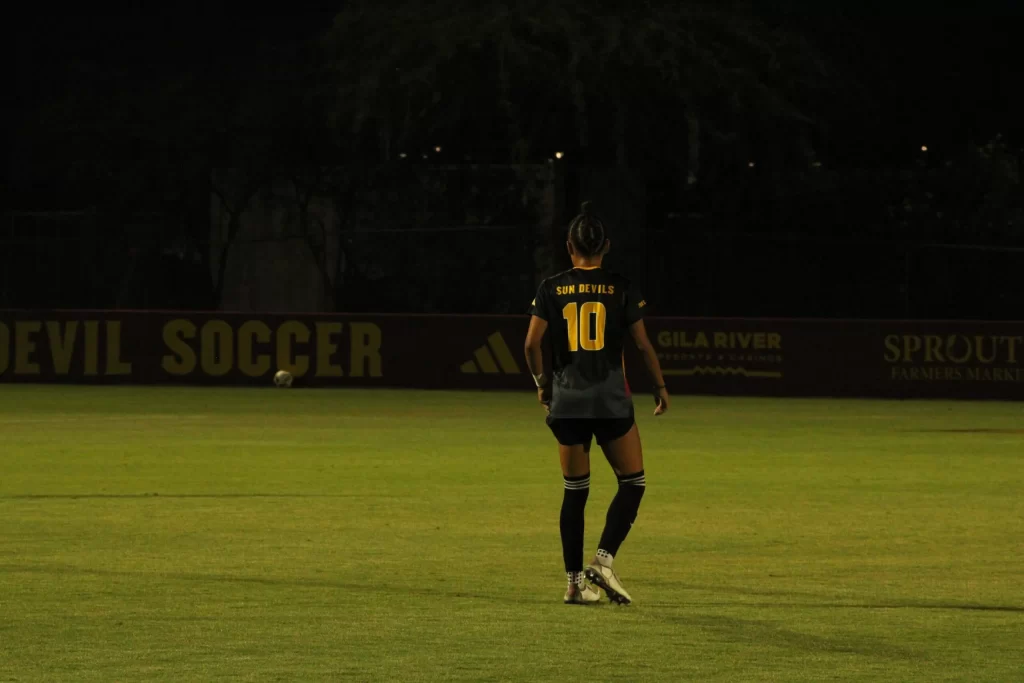Conference realignment and the abolishment of the Pac-12 caused waves throughout college sports. From those firmly against the changing landscape, much was made about the struggles of the new travel schedule for schools like ASU, which now had to travel cross-country in its new Big 12 athletic conference.
Football teams were always going to be ok, they have chartered flights and affluent budgets to afford plush hotels, and only one game a weekend. What about the other sports? People cried out. Sports like women’s soccer play two games a weekend and would now have to travel cross country for long stretches, affecting their ability to sleep well and keep up with their homework.
Well, according to ASU women’s soccer forward Enasia Colon, reality is often easier than perception. Travel wasn’t all that difficult.
“I personally thought it was pretty cool,” Colon said when we spoke over the phone. “Other people don’t like flying, but once they get there, it’s a pretty good experience. You see different places. I think it was pretty cool getting a change of scenery then the schools that we played before.”
It’s possible we, as media and the general public, overreacted to the changing of the times. People are often resistant to change, and dismantling a long-standing conference like the Pac-12, which was around for over a century, enflamed that resistance. People grasped at any gripe with the realignment to rebel against our new reality in order to preserve the past.
It’s time to let the conference as we knew it go, and to let this argument about the negative effects of travel go as well. Players on the women’s soccer team or men’s basketball team have harsher travel schedules than most, due to more games within a given week. However, they understand what comes with the territory of chasing their dream at the Division I level—even in the most extreme situations, such as a cross-country flight from Arizona to Orlando for UCF and ASU athletics, who are now conference foes in the Big 12.
“Yeah, that flight to Florida was pretty brutal,” Colon said. “Landing and then having to go to lunch, and then having a hotel, and then having to walk the field—it was just a lot. But at the end of the day, when you’re an athlete, you signed up for this.”
The fact is that every school that had to make the transition to this new reality had the resources to accommodate its athletes and ensure their school and mental health success. Study hall on away days out of town was mandatory. Advisors ensured the players were taking online courses and that assignments weren’t missed. It was never going to be as difficult as people tried to make it seem.
Some non-revenue sport athletes felt the effects, and sure, the longer travel can have its drawbacks on athletes. Hunter Hollenbeck, a senior on the diving team and the president of Stanford’s student-athlete advisory council, felt not just the effects of travel but also the time commitment that the longer flights and more days on the road took from everyday life.
“When Stanford recruits an athlete, we tell them you can do anything, any major, any sport, anything socially,” Hollenbeck told the Athletic in 2024. “But being an athlete now, it’s getting harder to preach that you can do anything. We’re coming to terms that athletics are taking much more time than we’re used to.”
There are challenges with being a student-athlete under any conditions. Having to travel great distances to games always posed a challenge, and conference realignment didn’t change that.
1,433 miles sit between the campuses of Arizona State and former Pac-12 opponent Washington. 1,175 miles sit between ASU and its new conference foe, Houston. While yes, the UCF flight might be a little more extensive than most, the general travel requirements between the new Big 12 and the old Pac-12 aren’t so dissimilar.
There will always be challenges. Colon faces them, too. But to continue to harp on the notion that there is this greatly increased travel load that affects the mental health of non-football players is simply not the reality of what they’re facing. The argument is used as a proxy to resist the changing landscape we grew so accustomed to. New conferences provide the opportunity for fresh new rivalries and matchups we haven’t seen in years—or ever.
Let go of the past and embrace the future, because the athletes already are.
“Sometimes it is frustrating,” Colon said. “Sometimes we don’t get to sit next to each other on the plane. But this past year, with being in the Big 12, it wasn’t too bad. A lot of people were nice and let us sit together. It just sucks because we didn’t get like, first class or anything, but that’s, just being picky.”


